|
"Canadians Know How to Fight"
The Canadian Regiment at the Battle of the Chateauguay
by Robert Henderson
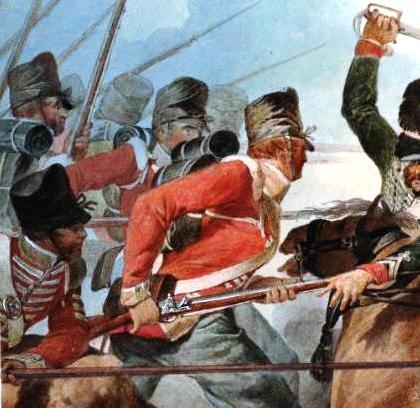
"Je crois à présent qu'un homme est capable
d'endurer sans crever plus de misère qu'un bon chien"
"I now know that a man can endure without dying more pain and
hell than a dog" - Lieutenant Charles Pinguet
On 8 August 1803 the War Office in London sanctioned the
raising of a Regiment of Fencible Infantry for service in Canada. The regiment was
to consist of one grenadier, one light infantry and eight battalion companies amounting to
over a thousand men in total. The light infantry company was to have one captain, two
lieutenants, five sergeants, five corporals, two drummers and 95 private men.
The first attempt at forming the Canadian Regiment of Fencible
Infantry came in late 1803 in the Scottish Highlands. It was hoped that the regiment could
be raised from a displaced population of highlanders wishing to emigrate to North America.
The combination of false promises from recruiting agents, poor living conditions in
Glasgow, distrust of the regiment's officers, and rumours that the regiment was going to
be sold to the East Indies Company for service in India brought the first Canadian
Fencible Regiment into open rebellion in late 1804. The mutiny was quickly put down and
the regiment was disbanded.
After this, the regiment's officers and several of its sergeants were
transferred to Canada to start over. Recruiting parties operated from Quebec City to
Niagara enticing young Canadians and immigrants to join the ranks of the new regiment.
Initially the regiment's recruiting campaign drew in few recruits. Most of the potential
recruits opted to join the much more established New Brunswick Fencibles (104th Regiment
after 1810). Nevertheless the regiment slowly began to grow. In 1808 the regiment was
officially embodied giving the men more regular issues of clothing and steady pay. That
same year the New Brunswick Fencibles was barred from recruiting in the Canadas. By
the outbreak of the War of 1812 the Canadian Fencible Regiment's strength had grown to
over 700 men.
Light Company Movements in the War
Shortly after the war's declaration the regiment's grenadier and light
infantry companies were detached and assigned to other duties. Adhering to the General
Order of 30 June 1812 these two flank companies were embodied with the flank companies of
other regular regiments in Lower Canada to form an elite Flank Battalion. The light
infantry companies were grouped together and placed under the charge of Major Plenderleath
of the 49th Regiment. This arrangement provided ample opportunities for the Canadian
Fencible light company to work in conjunction other regular light infantry and improve its
drill.
Formed in Quebec City, the Flank Battalion was dispatched to the Montreal
district in July and took up post at Blairfindie on the south shore of
the St. Lawrence River. While stationed
there during the autumn of 1812, considerable effort was taken to preserve each company in
the Battalion at a strength of eighty private men. In September the Canadian light company
was noted deficient of one sergeant, one corporal, two drummers and six privates. These
vacancies were ordered to be filled immediately with men from the Canadian Fencibles
"in every respect the best fitted for that service."
With winter coming on, the company in late November was ordered to take up
winter quarters at Halfway House just west of Chambly where it remained until May of the
following year. In the spring of 1813 the Canadian light company the company returned to
Chambly. By this time the Flank Battalion had been disembodied permitting several of the
regular flank companies to join their respective regiments in Upper Canada. The practice
of grouping flank companies was continued throughout the war whenever possible; especially
with embodied militia flank companies.
In late July a diversionary offensive on Lake
Champlain was ordered. It was hoped an attack on the Champlain frontier would cause
American military officials to direct reinforcements destined for the offensive on Upper
Canada instead to Lake Champlain. To accomplish this task, 900 regulars including the Canadian light company were
ordered to assemble at Isle aux Noix to set sail against American positions on the lake.
On 29 July the force, under Lt. Colonel Murray, left Isle aux Noix and on 31 July arrived
at Plattsburg, New York. The main body of troops, including the Canadian light company,
landed with little opposition. Once Plattsburg's militia had retired from the town,
Murray's force set about destroying the town's blockhouse, arsenal, barracks and public
storehouses. After Plattsburg, the force continued to Saranac were they found and
destroyed barracks capable of housing 4000 troops. In addition public buildings, barracks,
blockhouses and batteaux were destroyed all along the lake at places like Swanton and
Champlaintown. On 3 August Murray's force returned to Isle aux Noix bringing with them
large quantities of captured enemy supplies and equipment.
From Isle aux Noix the Canadian Fencible light company returned to Chambly, where
after over a year of absence rejoined the rest of the regiment. The reunion of the
Canadian Fencibles proved to be short-lived. At the end of August four battalion companies
were ordered to Upper Canada to bolster the number of troops protecting the St. Lawrence
river corridor. On 8 August the rest of the regiment, including the light company, were ordered first
to La Prairie, then to St. Philippe a month later. After a couple of weeks at St.
Philippe, the light company, along with two companies of the Regiment De Meuron and a
group of Sedentary Militia, was ordered in late September to the Douglas' Settlement near
the frontier (border). The small force took up their advanced post near the home of Nataniel
Douglas where they improved their defensive position by clearing the land of fences and
then constructed huts from corn fodder for shelter. After a three day stay at the Douglas'
Settlement the light company was ordered back to St. Philippe. After a night with the rest
of the Regiment, the Canadian light company with the grenadier company were again embodied
with the flank companies of other regular regiments (this time with the 13th and the
Regiment de Meuron) at St. Pierre in early October. Three days after forming, the new
Flank Battalion was ordered to Lacadie, while the Canadian light company was detached to
join the Canadian Voltiguers.
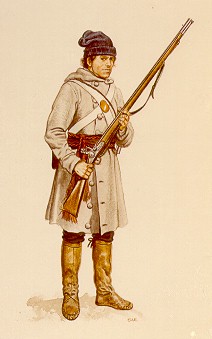
Sedentary Militiaman of Lower Canada by
G.A.
Embleton
(courtesy of Parks Canada)
The pace of the light company's movements prior to the taking up positions
on the Chateauguay river in October was surprising. In a short two-month period the
company had sailed against and destroyed American positions on Lake Champlain, marched,
counter-marched throughout the south shore of Montreal District, reconnoitred enemy
positions, all the time bivouacking along the way on boats, woods, farmer's fields, barns,
and houses, or encamping in garrisons or make-shift fortified positions. This pace
of activity was not exclusive to this group of soldiers. Troops remained on alert and were
juggled from post to post in anticipation of the expected American offensives from Lake
Champlain and down the St. Lawrence.
The Battle of the
Chateauguay
Once with the Voltiguers, the Canadian force,
accompanied by one hundred Indians advanced towards the frontier to reconnoitre an
American army of 5000 under General Wade Hampton which had advanced from Lake Champlain to
Four Corner, New York. After a brief engagement between the Indians and the American
advance guard, the Canadian force retired to Chateauguay were they remained for two weeks.
On the night of 21 October word arrived in Chateauguay that Hampton's army had crossed the
frontier and was advancing on Montreal.
Lieutenant Pinguet of the Canadian Fencibles, in a
letter to his brother: "We paraded at once and received orders to advance to the
forks three leagues further up the river Chateauguay. It was nearly day when we arrived
there; we rested about two hours when we were ordered to move on two leagues further. On
our march we met the Indians who had been sent ahead coming back to warn us that the enemy
was approaching at a distance of about two miles. We advanced nearly a mile when Colonel
de Salaberry... selected a strong position and extended us us in woods on either side of
the road. We were formed in tree lines [translation]." When the enemy did not appear
the small force consisting the Canadian Fencible light company, two Voltigeur companies,
and the light company of 3rd Battalion of Embodied Militia set about fortifying themselves
with trees and forming entrenchments. These entrenchments were occupied by Salaberry's
force for the next three days.
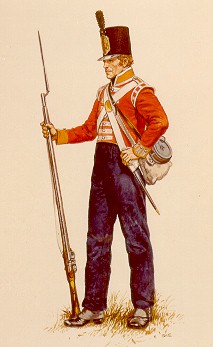
Soldier, Light Company of the 3rd Battn
of Embodied Militia by G.A. Embleton
(courtesy of Parks Canada)
On 24 October the construction of abattis was begun three miles in advance of their
position. Two days later, with the abattis nearing completion, the enemy advanced. Pinguet
picks up the story:
[When] our axemen were
completing [the abattis] a party of ten men of our company and twenty Voltiguers, who were
covering them, saw the advance of the enemy approaching. Our men fired upon them and
spread the alarm. Our company was sent at once to the abattis with orders to begin and
maintain the action... We had to contend with two thousand infantry and two hundred
cavalry. We lost no time. All our men fired from thirty-five to forty rounds so well aimed
that the prisoners told us next day that every shot seem to pass at about the height of a
man's breast or head. Our company was engaged for about three-quarters of an hour before
reinforcements came up [translation].
From this account Pinguet
gives the impression the Canadian Fencible light company was dispatched first to reinforce
the pickets. De Salaberry simply states that the picquets were "supported in time by
the Canadian Light company two companies of Voltiguers and the light company of the 3rd
Embodied Militia". In the battle the Canadian Fencibles, under the
command of Captain Richard Ferguson, were posted with twenty-two
Indians to the right part of the abattis were it meet with the woods. This part of the
defence works was the most vulnerable and prone to taking a flanking attack from the
Americans. Ferguson is noted armed with a shot gun and certainly joined in
the fire fight. Although little information exists about the exact tactical moves used by the
Americans on the flank, the amount of casualties may provide some idea.
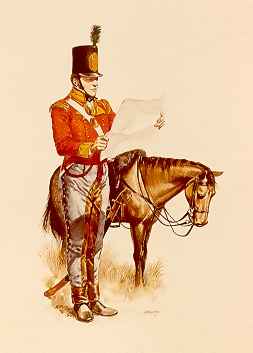
Officer, 3rd Battalion of Embodied
Militia of Lower Canada by G.A. Embleton
Unit served at the Battle of the Chateauguay (courtesy of Parks Canada)
In the four hour engagement the
Canadian Fencibles suffered 3 killed and 4 wounded; the two Voltiguer companies in the
centre received only 4 wounded; and the Embodied Militia on the left, who
received a
crossfire from Americans across the river, had 2 killed, 6 wounded and 4 missing. After
the Hampton's army had retired, De Salaberry wrote to Major General De Watteville on the
engagement. The first officer noted in his correspondence was the officer in command of
the Canadian Fencible Light company, Captain Ferguson: "I cannot conclude without
expressing the obligation I owe to Captain Ferguson for his cool and determined conduct
and his extreme readiness in executing my orders." Whether this refers to the company
arriving first to support the picquets is again uncertain. As for the other Canadian
Fencible officer present, Lieutenant Pinguet, the Témoin oculaire noted "On n'a pas
moins remarqué dans ce combat sévère, le courage et la bravoure du... lieutenant
Pinguet de l'infanterie légère canadienne..."
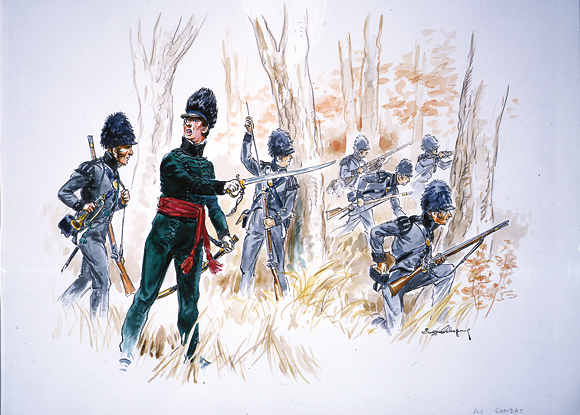
Candian Voltiguers skirmishing
(Parks Canada)
After the battle, the Canadian light company returned to their former entrenchments where
they remained for eight days exposed to the rain and frost, without fire or shelter. When
the Americans did not reappear the company was permitted to take up quarters down the
river at the farm of Jean Baptiste Malette. The men occupied Malette's barn while the two
officers housed themselves in Malette's house. At these accommodations Pinguet remarked
"we were nearly as badly provided for as in the woods." After eight days,
around 9 November, the company was ordered to return to their former entrenchments, in
expectation of an attack by Hampton to support the American army under General Wilkinson
moving down the St. Lawrence river.
Sickness quickly grew rapidly in both the American and
Anglo-Canadian armies as the weather grew progressively worse. The Canadian light company
and the other soldiers in the entrenchments was hit hard by sickness. Pinguet
describe the effects of the poor weather conditions to his brother: "We... suffered
so much from cold and foul weather that some of our men fell sick every day. I was forced
to return to the settlement with pain in every limb, but I hope to be able to rejoin my
company in a week if the campaign is not ended. Colonel de Salaberry has been
ill,... and several officers of the Voltiguers are sick too." The
suffering of the defenders come through in Pinguet's words: "I
now know that a man can endure without dying more pain and hell
than a dog." Still the young lieutenant was proud of
what had been at Chateauguay and was "convinced by this affair
that Canadians know how to fight." Several months later
the twenty-four year old Pinguet would die of a sickness contracted during this
campaign.
After Wilkinson's army was checked at the Battle of Crysler's Farm and
Hampton's army had entered winter quarters at Four Corners, N.Y., the light company was
ordered from its entrenchments on the Chateauguay river in late November to take up winter
quarters with the rest of the regiment at St. Philippe.
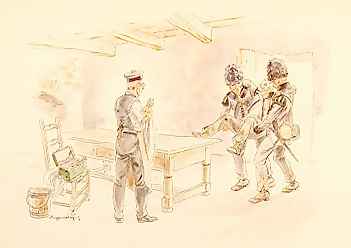
Wounded Canadian Voltigeur by Eugene
Leliepvre
(courtesy of Parks Canada)
The light company remained with the regiment for the rest of the war doing garrison duty
at St. Philippe, Prescott, and Kingston. After the war the Canadian Fencibles were
stationed at York and Fort George. In May 1816 the regiment was ordered to be disbanded at
Montreal. After disbanding, the soldiers of the light company received land grants
throughout Upper and Lower Canada and returned to civilian life.
Because the regiment was embodied in Quebec City and more than half the
regiment was made up of francophones, the regiment is today perpetuated by
the Royal 22e Regiment. In 2012, the regiment was awarded the battle
honour of CHATEAUGUAY.
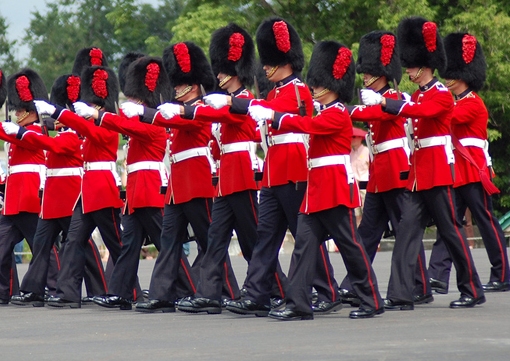
Royal 22e Regiment at the Citadel in Quebec City
|

